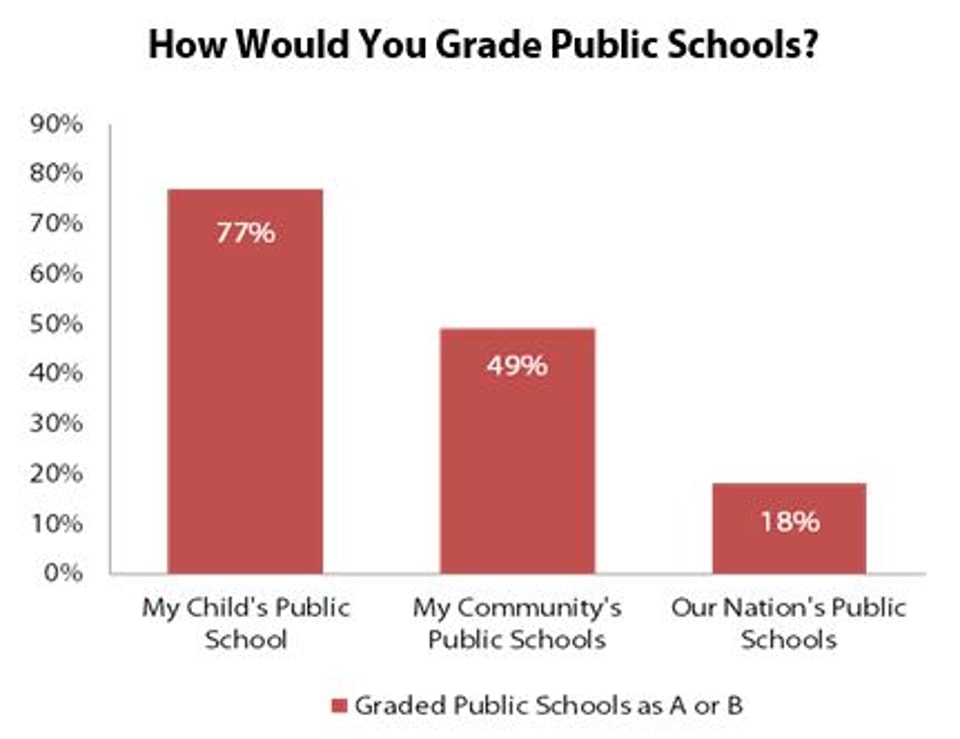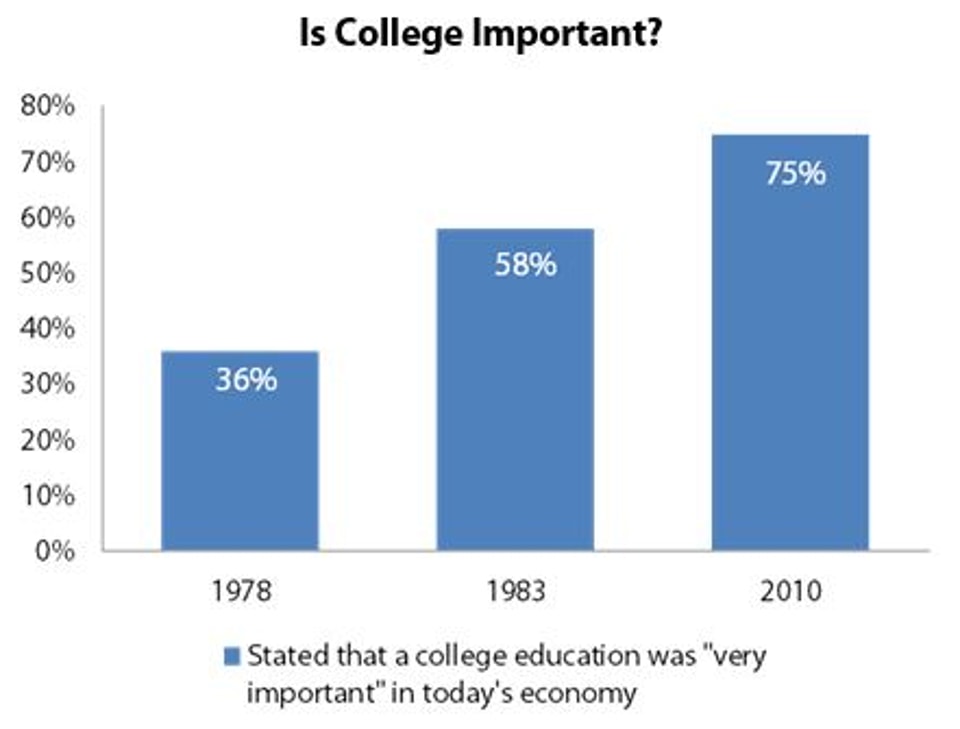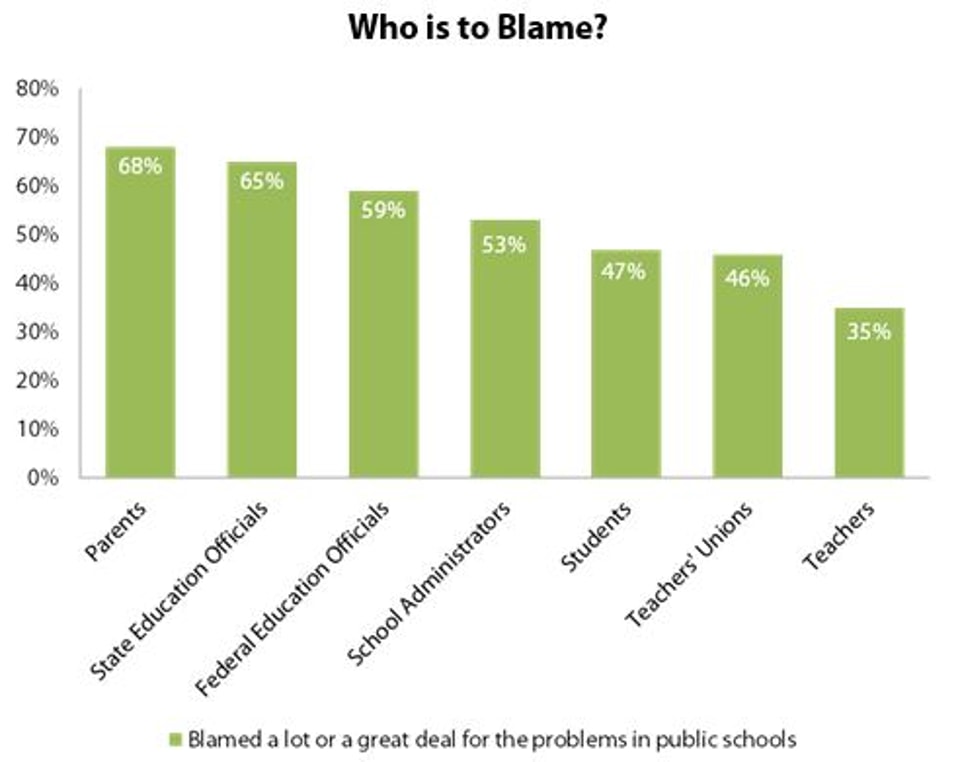Memo Published June 29, 2011 · Updated June 29, 2011 · 8 minute read
The Lake Wobegon Effect: A Survey of Public Opinion Research on Public Education
Tess Stovall
There are a series of disconnects when it comes to the public and the state of America’s public schools. Parents think that their own child’s school is stellar but think of the nation’s public schools as failures. They think their own child will graduate from college, but less than half of students actually go onto college. A cursory review of recent public opinion data revealed that the public’s Lake Wobegon views of America’s public schools, right or wrong, present large hurdles to jump in the process of improving and reforming public schools.
This memo surveys recent public opinion polls on public schools and public education in the United States. The first section reviews survey data on the public’s and parents’ opinions of their own schools and the nation’s schools as a whole. The second section examines the public’s views on how well schools are preparing young people to compete in today’s economy. The third section reviews public opinion research on who is to blame for the shortcomings of the U.S. public school system.
Section I: Not My School
In the U.S. today, there is a very distinct difference between the general public’s views of the quality of public schools in their community versus the nation as a whole. In one sense, this phenomenon could be similar to the old saying, “Americans hate Congress, but love their Congressman.” In many public opinion polls, the majority of Americans distrust the quality of the nation’s schools, but generally like their community’s public schools.
Most interestingly, parents of school-aged children have the highest opinion of local schools. Thus, the people who have the most direct experience with the public schools have the warmest feelings toward them, particularly when talking about their own school—regardless of whether or not their school is actually performing at the highest levels.
As the chart below shows, when policymakers talk about crumbling public schools, the vast majority of parents with children in public schools don’t think policymakers are talking about schools that their children attend but view it as someone else’s school

Source: Phi Delta Kappa/Gallup Poll, September 20101
Overall, there has been an erosion of public trust in the nation’s schools in the past few decades, although trust in America’s schools has long been in decline. In 1985, only 27% of Americans gave the nation’s public schools an A or B grade, compared to 18% today.2 While a slight majority of Americans believe in the quality of education at their local schools, they have lost confidence in the power of public schools to educate America’s children.
- 58% of Americans rate the quality of the education taught at their local public elementary school as either excellent or good, and 55% of Americans believe that the same holds true for their local high school.3
- But only 28% of Americans have a great deal or quite a bit of confidence in the institution of public schools.4
- Additionally, 44% of Americans think that the country is losing ground on the quality of public education.5
It’s clear that there is a disconnect in America about public schools. Americans are largely supportive of, and believe in, their local schools—but they have lost faith in the nation’s public education system. Given this nuanced view of public education, the rhetoric around failing, crumbling schools doesn’t necessarily resonate with the public when they think about the public school down the street. When parents hear policymakers talk about reforming the public education system, they may not think reform is necessary for their child’s “A” school. This is an important distinction worth understanding and exploring as the education reform movement moves forward.
Section II: Not My Child
Americans today understand the importance of a college degree, as the next chart shows. The number of Americans who believe college is important to achieve success has doubled—from 36% to 75%—the past 30 years

Source: Phi Delta Kappa/Gallup Poll, September 20106
Additionally, over the past three decades, the percent of public school parents that expect their children to attend college has increased by 60%

Source: Phi Delta Kappa/Gallup Poll, September 20107
Yet, the educational outcomes that parents expect and the reality of those outcomes are vastly different. Only 42% of high school graduates go on to a four-year college,8 and only 57% of those students who attend college will graduate with a four-year degree within six years.9 Thus, for every 100 students that graduate from high school, only 24 will graduate with a four-year degree.
Do Americans think that public schools provide students a quality education in order to succeed in a 21st century economy? It’s a mixed bag.
- 48% of Americans believe that their local public schools do an excellent or a good job at preparing students for college,10 but at the same time, 47% of Americans think that high school graduates today are less prepared overall for work or for college than they were when they were in school.11
- In terms of gaining the skills to succeed as an adult, 41% of Americans think that their local schools do an excellent or good job teaching students the practical skills that they need.12
- Overall, 34% of Americans see that most children are getting a better education today in public schools than they themselves received, while at the same time, 38% believe that children are receiving a worse education.13
The public has very contradictory views about the quality of education that public schools are providing and if public schools are truly preparing students to succeed in a 21st century economy. Similar to how the public grades their local school versus the nation’s schools, Americans are more likely to trust the educational quality of their community schools over that of the nation’s education system as a whole.
Additionally, although more Americans recognize the economic and social value of gaining a college degree and more parents expect their children to obtain it, we see that a minority of students graduate with a college degree, defying their parents’ Lake Wobegon beliefs and expectations.
Section III: Not My Classroom
There is plenty of rhetoric today about who is to blame for the quality of public schools, and the blame is placed on everyone from students to teachers to unions to federal officials. But when we look at how the public views responsibility over the state of America’s public schools, we see that Americans are much less likely to blame their own kids and teachers for the woes of the education system than they are to blame others outside the classroom walls

Source: The Associated Press/Stanford University Education Poll, September 23-30, 201014
It’s clear that a disconnect is also present in the public’s views about who is to blame for the challenges facing public schools today. They believe that those outside of the classroom are more to blame than those inside, and they blame other parents the most. It’s possible that the public develops a strong relationship with the teachers that they have had and those that teach their children, and thus, they are less likely to blame the people they know for the problems in public schools. Regardless of whether or not the public is correct in where it places blame, it’s an important distinction for policymakers and the education reform community to note.
Conclusion: Please Leave My School Behind
Four in ten parents believe that major changes are needed to America’s public schools,15 but based on this survey of recent public opinion polls, it would not be a large leap to assume that parents think that these reforms need to occur in someone else’s school, not their child’s school. Parents may want public school reform, but they seem uncertain about it for their own school.
There are numerous reform proposals being espoused to improve the public school system, and a 2010 NBC/The Wall Street Journal poll shows a varying degree of support by the American public for these reforms.16 Yet, the once widely-touted, bipartisan federal education reform measure of the last decade, No Child Left Behind, has not been well-received by the public. Three-quarters of the public believe that it has either made no difference to public schools or made them worse.17
There is a wide and significant disconnect in how Americans’ view public schools and the quality of education today. Their views change substantially for the positive when they think about their child, their teacher, and their school versus the amorphous national public education system. In future work, we hope to explore parents’ rose-colored-glasses view of public schools to determine if this is an accurate or warped sense of reality about public schools today, and how best to shape the conversation about how and why public schools need improvement.
